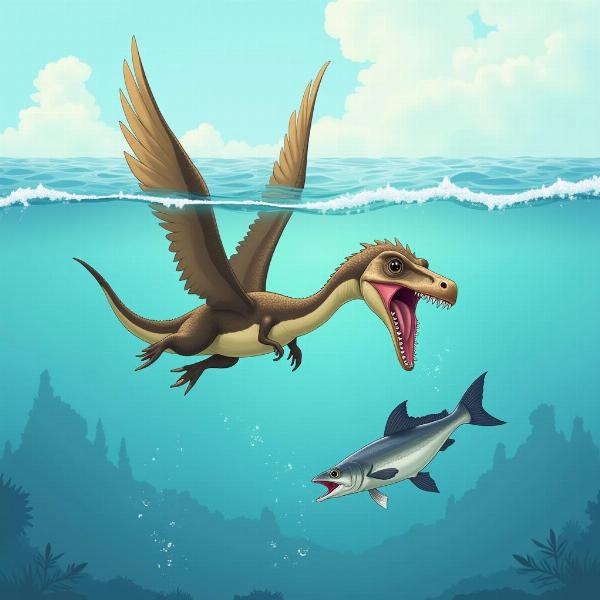Pterodactyl, a name often mispronounced and misunderstood, evokes images of giant, leathery-winged creatures soaring through prehistoric skies. But what does “pterodactyl meaning in hindi” actually translate to? While a direct, single-word translation doesn’t exist, understanding the term requires delving into both Hindi vocabulary and the fascinating world of paleontology. This article will explore the meaning, dispel common misconceptions, and provide accurate information about these mesmerizing creatures.
Decoding the Name: Pterodactyl’s Etymology and Hindi Equivalents
The word “pterodactyl” comes from Greek, meaning “winged finger.” In Hindi, the most accurate translation would be “पंखों वाली उंगली” (pankhon wali ungli), literally meaning “winged finger.” While this describes the creature’s defining feature, it isn’t a commonly used term. Instead, the more general term “उड़ने वाला डायनासोर” (udne wala dinosaur), meaning “flying dinosaur,” is frequently used. Although pterodactyls weren’t dinosaurs, this term serves as a recognizable approximation in everyday conversation. More scientifically, they are referred to as “टेरोसॉर” (terosaur), derived from the scientific classification Pterosauria.
Exploring the World of Pterosaurs: Beyond the Pterodactyl
While “pterodactyl” is often used as a blanket term, it technically refers to a specific genus within the larger group called pterosaurs. These incredible reptiles dominated the skies during the Mesozoic Era, alongside dinosaurs. They varied drastically in size, from the sparrow-sized Nemicolopterus to the colossal Quetzalcoatlus, which boasted a wingspan exceeding 36 feet. This diversity makes them a captivating subject of study.
Pterosaurs in Popular Culture: From Myths to Movies
Pterosaurs have captivated human imagination for centuries, inspiring myths and legends across cultures. Their imposing figures have made them popular subjects in modern media, from classic films like “King Kong” to contemporary animated movies. This widespread representation, while sometimes inaccurate, further contributes to the intrigue surrounding these ancient flyers.
Unveiling Pterosaur Characteristics: Unique Adaptations for Flight
Pterosaurs possessed unique adaptations that allowed them to conquer the skies. Their wings, formed by a membrane of skin stretched between their elongated fourth finger and their bodies, were unlike anything seen in birds or bats. Their lightweight, hollow bones and powerful muscles further facilitated their aerial prowess. These distinct features set them apart from other flying creatures and make them a fascinating study in evolutionary biology.
What did Pterodactyls Eat?: Diet and Hunting Strategies
Pterosaurs exhibited a diverse range of diets, depending on their size and habitat. Some, like Pteranodon, were piscivores, diving into the water to snatch fish. Others were insectivores, while larger pterosaurs may have preyed on small land animals. Their diverse feeding habits reflect their adaptability and ecological roles within the prehistoric ecosystems.
 Pterosaur hunting fish
Pterosaur hunting fish
Conclusion: Pterodactyls – A Window into Prehistoric Skies
Understanding the “pterodactyl meaning in hindi” goes beyond a simple translation. It opens a door to exploring the fascinating world of pterosaurs, their incredible adaptations, and their significant role in Earth’s history. These magnificent creatures continue to inspire awe and curiosity, reminding us of the incredible diversity that once graced our planet.
FAQ:
- What is the correct pronunciation of “pterodactyl”? The correct pronunciation is /ˌtɛrəˈdæktɪl/.
- Were pterodactyls dinosaurs? No, pterosaurs were closely related to dinosaurs but belonged to a distinct reptilian group.
- What was the largest pterosaur? Quetzalcoatlus is considered the largest known pterosaur, with a wingspan of over 36 feet.
- What did pterosaurs eat? Pterosaurs had diverse diets, ranging from fish to insects to small land animals.
- When did pterosaurs live? Pterosaurs lived during the Mesozoic Era, from the late Triassic to the end of the Cretaceous period.
- How did pterosaurs fly? Pterosaurs flew using large, leathery wings supported by an elongated fourth finger.
- Why are pterosaurs important? Pterosaurs represent a unique evolutionary adaptation to flight and provide valuable insights into the ecosystems of the Mesozoic Era.
Related Articles:
Meaning-Hindi.in is your premier destination for professional Hindi translation services. We specialize in business and commercial, legal, technical, website localization, educational, and specialized translations. Our expert team ensures accurate and culturally sensitive translations to meet your specific needs. Whether you need a quick translation or a complex project, Meaning-Hindi.in offers reliable and efficient solutions. Contact us today at [email protected] or +91 11-4502-7584 to discuss your translation requirements.